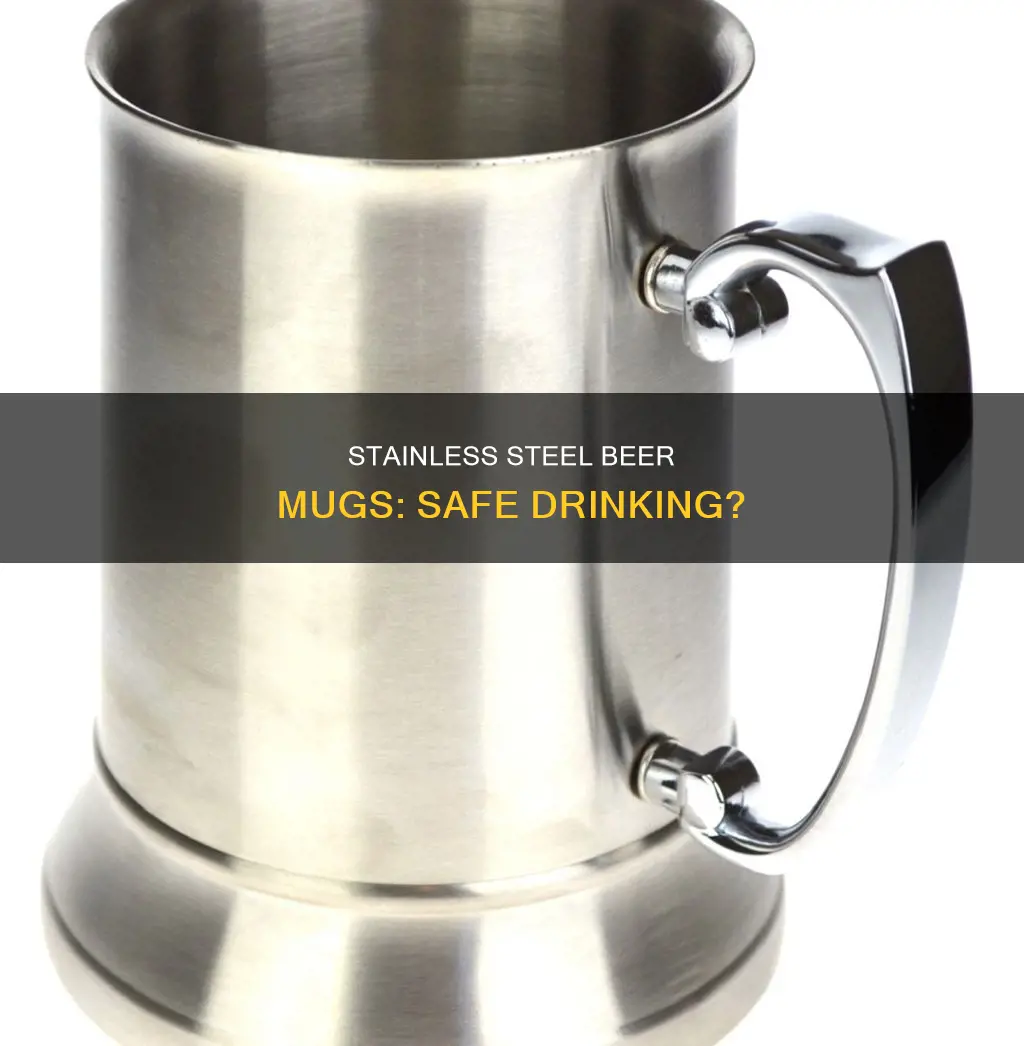
There is much debate about whether it is safe to drink beer from a stainless steel cup, with drinkers often concerned about a potential metallic taste. Stainless steel is commonly used in brewing equipment and beer is often stored in stainless steel kegs for long periods of time, so it is unlikely that stainless steel would affect the taste of beer. However, some people are extremely sensitive to the effects of metal and may be able to taste it. Stainless steel is generally inert and does not react with food or beverages, but recent studies have shown that prolonged storage of acidic drinks in stainless steel containers can result in the leaching of metals such as nickel and chromium, which can be harmful to health.
| Characteristics | Values |
|---|---|
| Safety | Drinking beer from stainless steel cups is safe |
| Metallic taste | Stainless steel does not affect the taste of beer. However, some people might experience a 'metallic' taste due to the smell of the metal clashing with the beer's distinct smell |
| Corrosion | Stainless steel is resistant to corrosion from beer |
| Discoloration | Stainless steel is resistant to discoloration from beer |
| Rust | Beer does not cause rust in stainless steel |
What You'll Learn

Stainless steel is inert and doesn't react with food or drinks
Stainless steel is inert, meaning it doesn't react to food or drinks. This is due to a thin, transparent layer of chromium oxide that covers the steel and acts as a protective barrier. This layer means that stainless steel doesn't dissolve in water, conduct electricity, or react with your saliva, so you can't taste it.
This is why stainless steel is commonly used in brewing equipment and beer kegs. Beer is often left in stainless steel kegs to ferment for about two weeks, and draft beer is usually packaged in unlined stainless steel kegs. If stainless steel affected the taste of beer, this would be a disaster for brewers!
However, it's important to note that not all stainless steel is created equal. There are different grades of stainless steel, and some are more susceptible to corrosion and leaching of metals than others. For example, 201 stainless steel is more likely to rust and leach metals like nickel and chromium, which can be harmful to health. 304 stainless steel is considered food-grade and is more resistant to corrosion, but it's not entirely safe either. Prolonged exposure to acidic drinks can still cause metal leaching, and studies have shown that higher temperatures increase the concentration of nickel and chromium in the liquid.
So, while stainless steel is generally inert and safe to drink from, the quality of the steel and the type of drink can make a difference.
Beer and Colonoscopy: What's the Safe Timeline?
You may want to see also

It's safe to drink beer from stainless steel cups
Stainless steel is widely used in brewing equipment and beer is often stored in stainless steel kegs for weeks or even months before it's consumed. If you're tasting metal when drinking beer from a stainless steel cup, it's likely because your mouth is in direct contact with the metal of the container. However, most people shouldn't taste anything when drinking from clean stainless steel.
It's worth noting that not all stainless steel cups are made equal. Stainless steel comes in different grades, with 304 stainless steel being more resistant to corrosion than 201 stainless steel. Recent studies have found that prolonged storage of acidic drinks in stainless steel containers can result in leaching of metals like nickel and chromium, which can have adverse health effects. Therefore, it's recommended to use 304 stainless steel, which is considered food-grade, for your drinkware.
Additionally, stainless steel cups can alter the drinking experience. Since they are not see-through like glass, you rely solely on your sense of smell and taste when drinking from them. This can sometimes result in a perceived "metallic" taste, even though the metal is not actually changing the taste of the beer.
Drinking Beer and Driving in Mississippi: What's Allowed?
You may want to see also

Stainless steel doesn't affect the taste of alcohol
Stainless steel is a common material used in brewing equipment and the storage of alcoholic beverages. The metal is resistant to corrosion and discolouration from most substances due to its passive layer, a thin, transparent layer of chromium oxide that is inert and doesn't react with water.
While drinking from a stainless steel cup is safe, some people report experiencing a "metallic" taste. This is not caused by the steel itself, as it does not react with acidic substances, but rather by the smell of the metal interacting with the distinct smell of the alcohol. The stainless steel cup also obstructs sight of the beverage, and so drinkers are more reliant on their senses of smell and taste to identify the beverage, which can lead to confusion.
To avoid a metallic taste, it is recommended to avoid drinking corrosive or easily spoiled liquors such as carbonated, acidic, or citrus-flavoured beverages from stainless steel cups, as these can pick up metallic flavours.
Beer Drinking on Guadalupe River: What's Allowed?
You may want to see also

Beer doesn't cause rust in stainless steel
Beer is made with water, yeast, flavouring, and alcohol. While the water in beer can cause rust in metals, it doesn't cause rust in stainless steel. This is because stainless steel has a passive layer on its surface that is very resistant to corrosion.
Stainless Steel in the Brewing Process
Stainless steel is commonly used in the brewing process. It is durable, corrosion-resistant, has low reactivity, and is easy to clean and sanitise. It is also affordable compared to other materials such as copper or aluminium.
How Beer Interacts with Stainless Steel
Beer is an acidic substance, but stainless steel does not react with acidic substances. This means that the metal will not dissolve into the beer and alter its flavour. However, drinking beer from a stainless steel cup may give it a "metallic" taste. This is not because the beer has gone bad, but because the smell of the metal clashes with the smell of the beer.
Proper Care for Stainless Steel
To ensure that your stainless steel cups remain in good condition, it is important to clean them regularly. Use mild detergent or soap with warm water and a soft cloth or sponge. Avoid using abrasive materials or bleach, as these can damage the chromium oxide layer on the surface of the stainless steel.
Powerlifters and Beer: A Match Made in Heaven?
You may want to see also

Stainless steel drinkware might not be as safe as perceived
Stainless steel cups, mugs, tumblers, and other drinkware are extremely popular due to their desirable attributes. They are lightweight, keep drinks hot or cold, and are unbreakable, unlike ceramic or glass cups. However, recent studies have shown that they might not be as safe as people think.
One of the reasons why stainless steel drinkware is so commonly used is because of the perception that it is safe to drink from. Stainless steel is inert, meaning it does not react to food or beverages, including acidic ones such as tea or lemon juice. This is in contrast to other metals, which can react with acids over time, creating harmful chemicals.
However, not all stainless steel drinkware is created equal. Stainless steel comes in various grades, with 304 and 201 being the most commonly used for drinkware. 201 stainless steel is more susceptible to corrosion and rusting than 304. Recent studies have found that prolonged storage of acidic drinks, such as fruit juices, tea, and coffee, in stainless steel containers can result in significant leaching of metals like nickel and chromium. These metals can have adverse effects on health. Nickel is a common cause of allergic contact dermatitis, while ingested chromium can increase the risk of cancer, particularly lung cancer.
The findings from these studies also show a correlation between the grade of stainless steel and the level of metal leaching, with 201 being more susceptible. 304 stainless steel is considered food-grade and is recommended as the minimum grade for drinkware. However, even 304 stainless steel is not entirely safe. Studies show that longer exposure to acidic drinks and food at higher temperatures can corrode even this grade of stainless steel, leading to increased leaching of nickel and chromium.
While stainless steel is generally resistant to corrosion and rust due to its thin layer of chromium oxide, this protective layer can be damaged by prolonged exposure to acidic drinks. Organic acids in these drinks can constantly attack the protective layer, and it may not have a chance to reform before the acids corrode the stainless steel itself.
While the exact conditions that lead to harmful levels of metal leaching are still being researched, the danger of harmful metal leaching is definitely present, especially if low-quality stainless steel drinkware is used. Stainless steel drinkware might, therefore, not be as safe as commonly perceived, and consumers should be cautious and opt for high-quality, food-grade options.
Beer and Lamisil: Is It Safe to Mix?
You may want to see also
Frequently asked questions
Yes, it is safe to drink beer from stainless steel cups. The surface of stainless steel is resistant to corrosion and discolouration from most substances due to its passive layer.
No, drinking beer from stainless steel glasses does not affect its taste. Stainless steel does not react with acidic substances, so the chances of the metal dissolving into the alcohol and altering its flavour are slim.
If you experience a metallic taste when drinking beer from a stainless steel cup, it is likely because your mouth is in direct contact with the metal of the container. However, if you are drinking beer from certain metallic cups, such as copper mugs, you should be cautious as they can lead to copper poisoning when used in excess.
No, beer does not cause rust in stainless steel. Rust occurs when the surfaces of a metal are exposed to air, moisture, high temperature, or other environmental factors. The passive layer on the surface of stainless steel is very resistant to the corrosive properties of beer.







